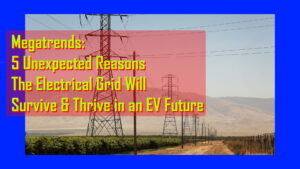

One of the most repeated arguments against electric vehicles is that the electric power grid can not handle tens of millions of electric vehicles. This is simply false, but not for the reasons you may suspect:
Probably the biggest mistake pundits infer is that by 2035 all vehicles will be electric when in fact that will not happen until the early 2040’s, some 20 years from now.
People did not burn their filing cabinets or shoot their horses when computer hard drives replaced filing cabinets, and tractors replaced work animals; it was a transition, not a hard cutover.
The demand from EV’s will be drastically more gradual than many are predicting. Currently electrified vehicles account for only about 5% of new vehicle sales in the United States and Canada.
There are about 289 million vehicles on the road in the US, with an average age of 12.1 years. SOURCE
Add to that Canada’s 35 million vehicles, almost all of which are gas / diesel powered. Those millions of existing gasoline powered vehicles will not be eliminated from roads magically in 2035. Instead they will be removed from the roads as they die, just like other technologies, over decades.
Energy utility companies are working furiously (and creating new jobs!) upgrading you local substation, their regional transmission lines and their electrical generation capacities. These are all long term investments that utilities are used to dealing with.
As pointed out in our video below, our electrical grid survived the air conditioner boom of the 1970’s and the computer boom in the 1990’s, because the electric utility companies are filled with professionals predicting and building for the future.
It should not come as a surprise that companies who employ literally tens of thousands of engineers, statisticians and efficiency experts have come up with a way to game the system.
You may be surprised to learn that many electric vehicle charging companies are beginning to invest in battery storage so they can charge during overnight hours when they receive massively discounted pricing from electric utilities. Those companies then sell consumers like you and me electricity at higher daytime prices.
There are also many ways to store electricity that do not involve batteries. You can stack heavy cement blocks, pump air into large balloons in your nearest lake, or chilling / compressing air during the times of high or cheap electrical production, can be turned around and consumed by unstacking cement blocks, letting the water pressure push the air out of balloons or having air warm up and expand, to produce electricity when we all need it. Click HERE for a few more interesting chemical battery alternatives.
Utility companies that run the power grid build their infrastructure to support about 25% more than peak demand. This occurs between 3pm and 6pm 5 days a week when households start serious drain on electricity when the kids get home from school and dinner is made, at the same time that both industry and commerce is at full tilt consumption.
What happens to all that electrical infrastructure at night? Right now, the answer is not much. So utility companies have big incentives to encourage EV owners to charge overnight from about 9pm to 7am. That is a 10 hour golden period when the electric grid is also mostly sleeping.
To make this a reality, many electric companies are providing “Time Based Electrical Pricing” (TBEP) or “Time of Use” (ToU) pricing or “Real Time Pricing” (RTP) which simply means electricity consumers pay less overnight than they do during the day. If this is not already happening in your region, it will in the NEAR future.
In a word, innovation. Those who have bet against technological innovation have a 250 year track record of failure. The whole EV ecosystem is driving forward new technologies at a break-neck pace so we should all be surprised and thrilled with unanticipated innovations, but none of us should be shocked (pun intended!) by them.
One of the most interesting innovations is the advent of incredibly cheap solar panels. As you can see in the video above, utility companies are now thinking that when the sun shines the brightest in the early / mid afternoon is when we may have too much electricity production in the near future and we can use electric vehicles to store the surplus. Electric utility companies have a serious financial incentive to give you, the EV owner, a discount on the price you are paying during these periods of excess production AND they may even buy some of that power back from you in the late afternoon to help them supply peak demand. The so called “smart grid” or “reverse grid” is not the most efficient solution, but it is and will be one of the many previously unanticipated tools in the electrical grids power tool box.
EV manufacturers, electrical grid operators, power producers, local utility companies, governments at all levels, universities, high tech start ups, and even traditional car manufacturers, are all keenly aware of the need for rapid changes and most of them do not see doom and gloom; they see vast opportunities that will amaze us all.
The electrical power grid will have problems in the future, just like it does now. However, the transition to EV’s is seen by power producers and local utility companies as a golden opportunity to both expand their business and to replace a lot of decrepit electrical infrastructure that should have been changed out decades ago.
The grid will flourish with the new opportunities that EV’s bring to the market, to you personally and incidentally to the environment.
This website uses cookies.